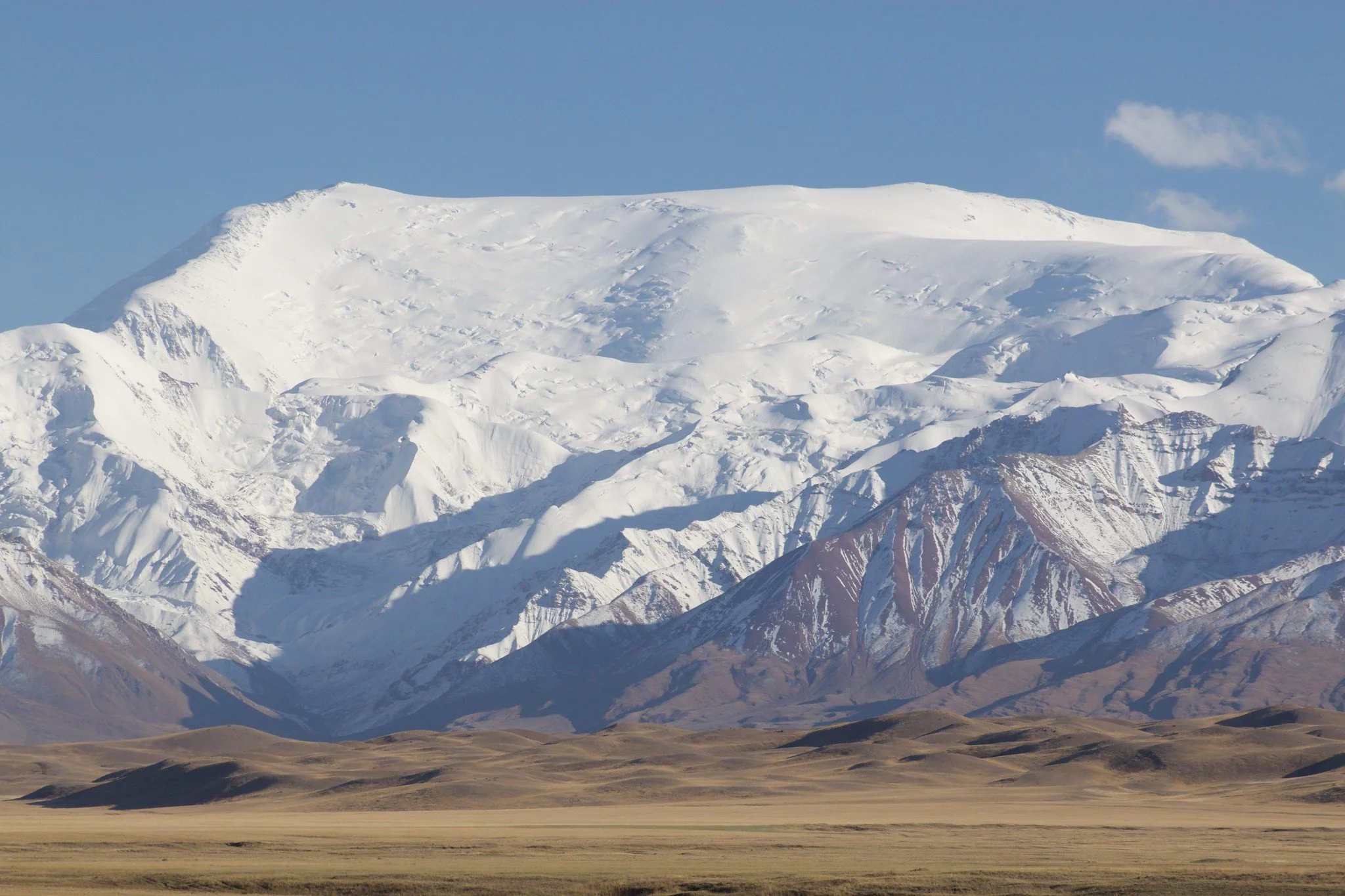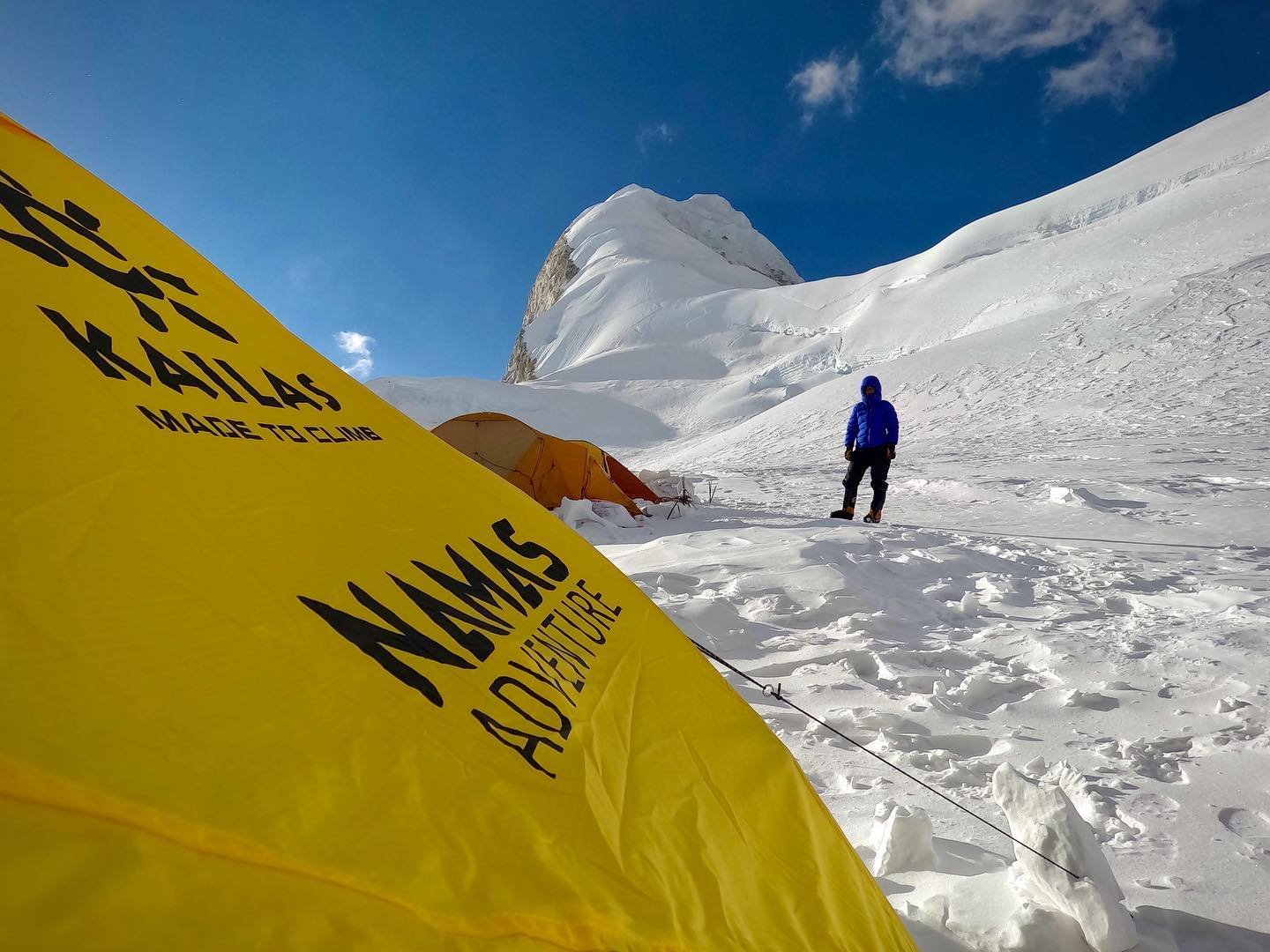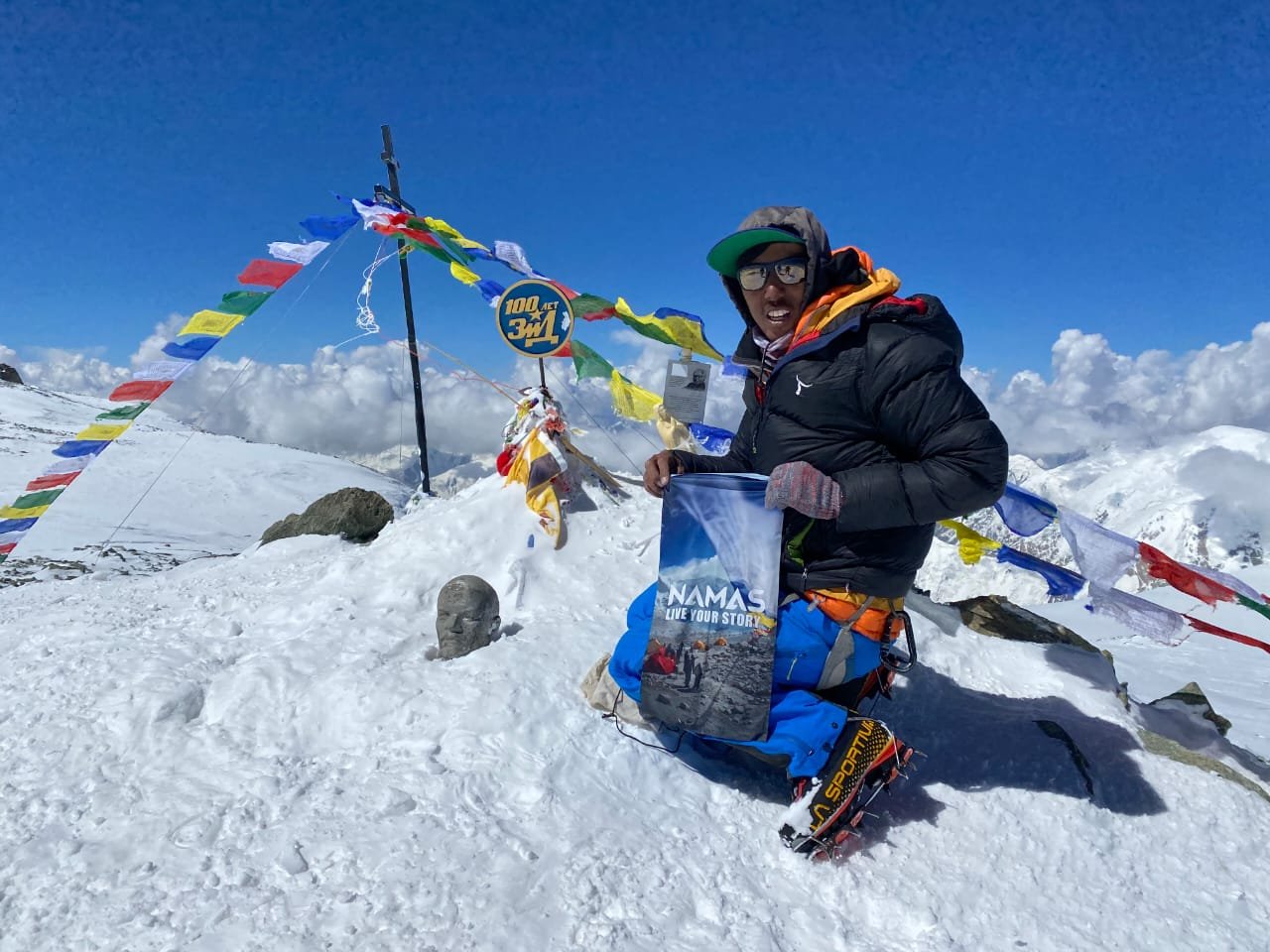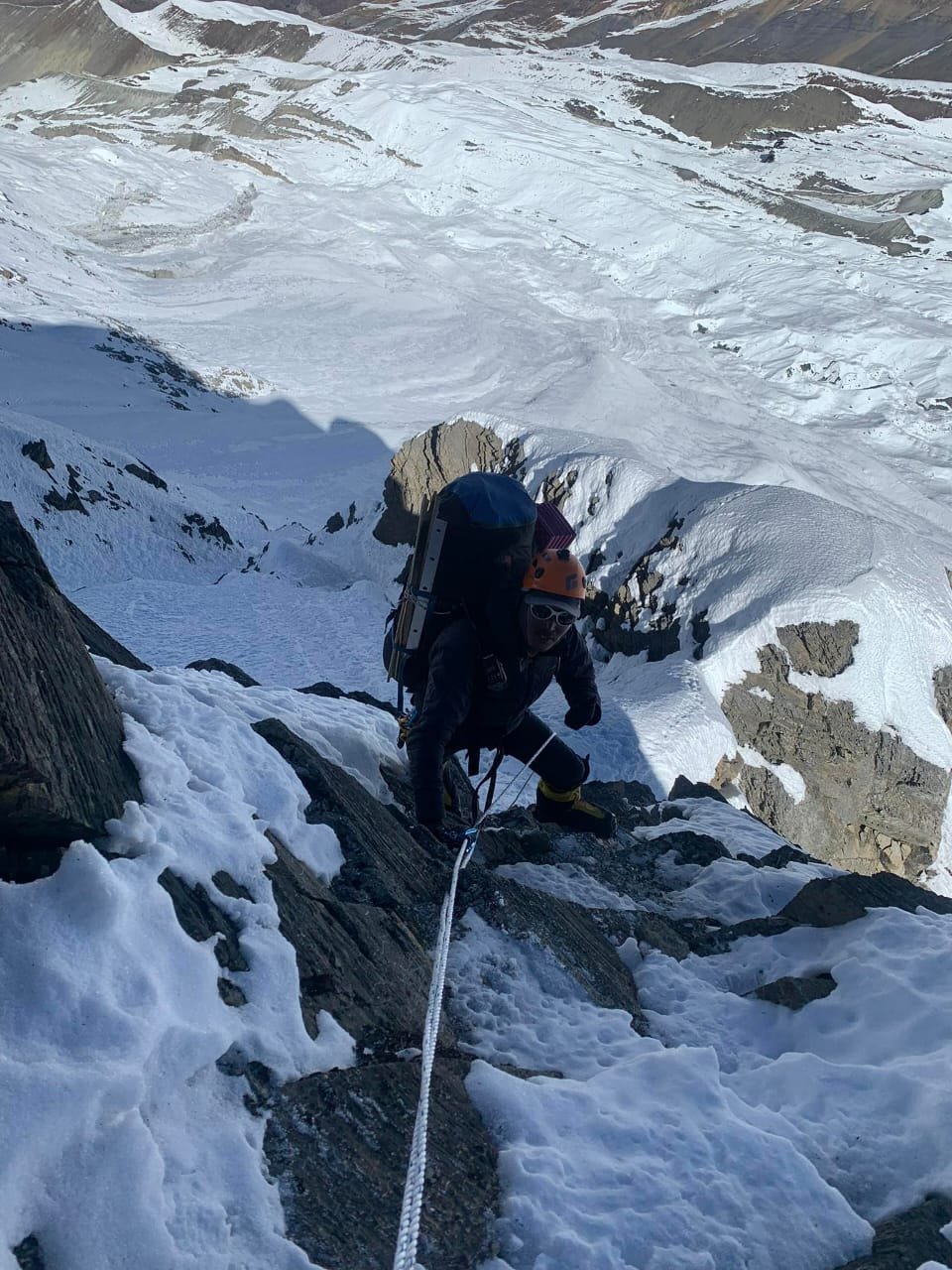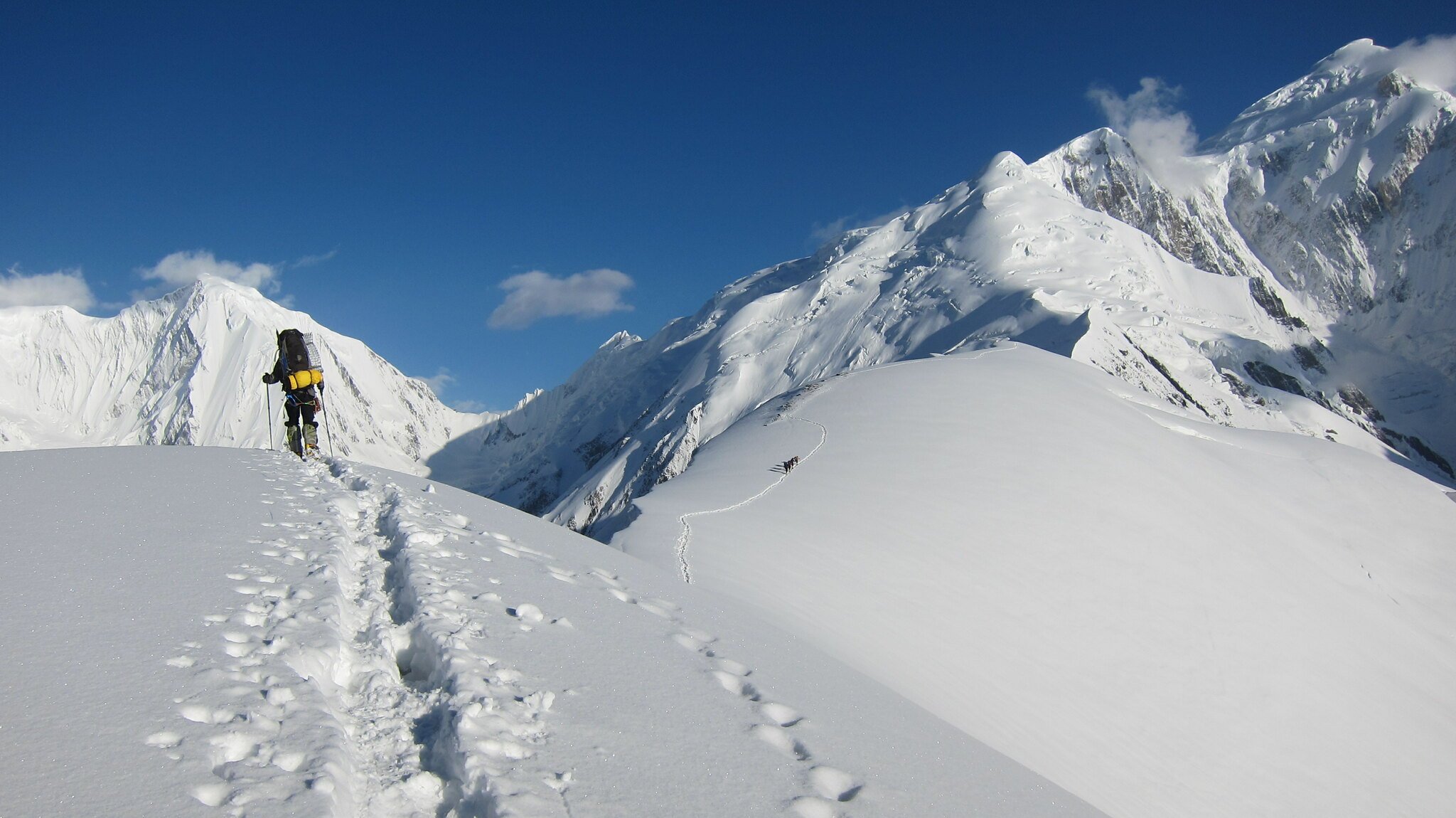Lenin Peak Expedition (Experience, fitness level and skills) requirements - Namas Adventure
What previous experience is required to climb Himlung Himal?
Preparing to climb Lenin Peak is not something to be taken lightly. This peak, at over 7,000 meters, may be classified as a non-technical climb compared to other high-altitude summits, but it still presents serious obstacles that require careful planning, training, and skill development. Here's a more detailed look at what you'll need to get started and succeed on this expedition.
Climbing Experience & Skills:
To climb Lenin Peak, it’s essential to have some solid alpine experience. If you’ve already climbed a 6000m peak, that’s a great start! You should be comfortable with the basic techniques used in mountaineering: using crampons, navigating steep icy terrain, and mastering fixed ropes. These foundational skills will ensure you’re prepared for the challenges at higher altitudes, like the ones you’ll encounter on Lenin Peak. If you’ve never used these tools before, it’s worth taking a mountaineering course to familiarize yourself with them. In addition to basic climbing skills, experience in the mountains (especially at altitude) is crucial. Understanding how your body responds to thin air, knowing how to pace yourself, and having a grasp of the mental fortitude needed to continue pushing forward when exhaustion sets in are vital aspects of this journey.
Fitness Level:
The physical demands of climbing Lenin Peak cannot be overstated. The climb requires stamina, endurance, strength, and mental toughness. Summit days can last over 16 hours—meaning you’ll need to be in peak physical condition. Training should be focused on building cardiovascular endurance, leg strength, and overall endurance. Consider incorporating activities like long-distance running, cycling, and hiking with a weighted backpack into your regimen. Hiking with weight (around 20 kilograms) simulates the conditions you’ll experience during your climb, helping your body adapt to the intense physical demands. Aside from physical endurance, you’ll need to train for the mental challenge. Staying focused and calm during long, grueling hours on the mountain is often the deciding factor between success and failure. As such, you should incorporate stress management and mental conditioning into your training as well.
Essential Skills to Master:
Guides will emphasize the importance of mastering a few basic skills before attempting the climb. These skills include:
- Tying a figure 8 knot and a stopper knot at the end of the rope to ensure your safety.
- Ascending/jumaring on fixed lines and abseiling with a super 8 belay device or ATC descender in multi-pitch sections. This skill is crucial for safe descent and avoiding errors.
- Climbing, traversing, and hiking with crampons on ice, rock, and snow for extended periods. Practice will help you maintain stability and efficiency on challenging terrain.
- Performing a snow arrest and safely recovering if you slip and slide. This technique is vital for self-rescue and preventing falls.
Continued Practice:
If you don't have mountains nearby, rock climbing both indoors and outdoors is a great way to maintain your rope skills and stay in climbing shape. This practice helps you stay mentally sharp and physically fit.
Expedition Support & Logistics:
Choosing the right expedition company is just as important as your physical and mental preparation. A good company will provide logistics, guides, and support to ensure the safety and success of the expedition. They will help with acclimatization schedules, gear requirements, and on-the-ground logistics, allowing you to focus on your climb. Remember, the guides you’re paired with will have a wealth of experience, and their knowledge can be invaluable. Trust their judgment and follow their advice to maximize your chances of success.
Training Recommendations:
You should begin preparing 3-4 months before your climb. Prioritize endurance training—long-distance running, cycling, and hiking with a weighted backpack are great for building the stamina needed for the summit day. Additionally, strength training focused on your core and legs will help you tackle tough sections of the climb, such as steep ascents and difficult descents. Mentally, try to prepare for the demanding nature of the expedition. It’s easy to get frustrated when fatigue sets in, but mental strength will be what gets you to the summit. This means being prepared for setbacks, weather delays, and difficult moments on the mountain.
Final Thoughts:
Climbing Lenin Peak is not just about the summit—it’s about the journey, the lessons learned along the way, and the personal growth that comes with pushing yourself beyond what you thought was possible. With thorough preparation, dedication, and the right mindset, you can make this incredible adventure a reality. Keep in mind that this is a high-altitude, physically demanding climb, so no matter how prepared you think you are, always be prepared to listen to your body. Altitude sickness is a real concern, and recognizing its early symptoms could save your life. So, go ahead- Push your limits. And most importantly, enjoy the adventure. The summit is waiting for you.
**Live Your Story!
NAMAS Adventure Team**
Lenin Peak 7134M Expedition strategy - Namas Adventure
If you’ve been dreaming of summiting a 7,000-meter peak, Lenin Peak should definitely be on your radar. Situated on the border between Kyrgyzstan and Tajikistan, Lenin Peak stands at 7,134 meters, making it one of the most accessible summits in the world for mountaineers seeking a high-altitude challenge.
For climbers with prior experience on peaks between 4,000m to 6,000m, Lenin Peak is an excellent next step. It offers a mix of technical challenges and breathtaking landscapes, while being achievable with the right preparation and strategy.
Our Strategy for the Climb: Focus on Safety and Enjoyment
While Lenin Peak is considered one of the more accessible 7,000-meter mountains, it still poses some challenges. From harsh weather and crevasses to high-altitude conditions, the ascent requires careful planning and a solid climbing strategy.
Our approach is focused on gradual acclimatization, safety, and pacing ourselves through each stage of the journey. We’ve designed our route with the goal of ensuring every climber has a rewarding, successful experience. With this strategy, climbers will be able to tackle each stage of the ascent and have a strong chance at summiting safely.
The Journey Begins: Base Camp to Camp 1 (4,400m)
The adventure kicks off at the IMC "Pamir" base camp in the stunning Achik-Tash valley. After a day of rest and acclimatization, we’ll set off toward Camp 1, located at 4,400 meters. This first stretch takes you across the Lenin Glacier, where you'll navigate crevasses and snow-covered slopes. While the technical difficulty is moderate, it’s important to take it slow and allow your body to adjust to the increasing altitude.
The Rotation Phase: Preparing for the Final Push
Before attempting the final summit, acclimatization and building endurance are key. The rotation process involves climbing between IMC 'Pamir', Camp 1, Camp 2, and Camp 3, gradually gaining altitude, and then descending back to IMC "Pamir" for rest. This allows your body to adjust to the thinner air and prepares you for the final push to the summit. Climbers will make two or more rotations between these camps before heading to the summit. Each rotation helps climbers test their gear, optimize their techniques, and adjust to the altitude.
It’s essential to take this rotation phase seriously, as it maximizes your chances of success and safety on summit day. By the time we’re ready for the final push, you’ll be fully prepared.
Acclimatization: Home Peak or Yuhin Peak
Before ascending to Camp 2, we’ll spend two days preparing for the climb by making acclimatization hikes to Home Peak (4,750m) or Yuhin Peak (5,130m). These hikes will help your body adjust to higher altitudes and further prepare you for the ascent.
Camp 1 to Camp 2 (5,300m): Getting into the Groove
From Camp 1, we’ll ascend toward Camp 2, which sits at 5,300 meters. The terrain here involves crossing the dry Lenin Glacier and climbing long snow slopes. This section is challenging, but the scenery and the sense of progression will keep you motivated. By this point, we aim to give climbers ample time to acclimatize to the altitude and prepare for the more strenuous climbs ahead.
Camp 2 to Camp 3 (6,100m): The Big Push
From Camp 2, we will make our way to Camp 3 at 6,100 meters. This part of the journey will test your endurance, but the views of Razdelnaya Peak (6,148m) and the surrounding Pamir Mountains will make it worthwhile. From here, you’ll gain a new perspective on the Alai Plain to the north and the snow-capped peaks to the south. The climb to Camp 3 is physically demanding, but the summit ridge becomes visible, adding to the excitement of the ascent.
Return to IMC "Pamir" for Rest
After completing the rotation up to Camp 3, we’ll descend back to IMC "Pamir" to rest and allow our bodies to recover. This rest period is importance for ensuring that climbers are well-prepared for the summit push, allowing time for recovery and final adjustments.
Summit Push: The Final Ascent
Once rested and prepared, we’ll begin our summit push, following this progression:
- IMC "Pamir" to Camp 1
- Camp 1 to Camp 2
- Camp 2 to Camp 3 Finally, the most challenging part of the journey:
Camp 3 to Summit (7,134m): The Final Ascent
After completing the necessary rotations and returning to IMC "Pamir" for rest, climbers will be ready for the summit push. From Camp 3, the summit ridge becomes visible, signaling that the final climb is near. Depending on energy levels and weather conditions, climbers may choose to ascend in one go or set up an additional camp at 6,400 meters for a more gradual approach.
The final climb to the summit is demanding. It begins with reaching a pass through snow-covered slopes that are steep (about 50°) and exposed. As we continue to ascend, the slopes become less steep, and we navigate a few flatter sections. The steepest part of the climb occurs along the ridge, where we’ll install fixed ropes for safety. Once past this section, it’s a final push to the top. The summit of Lenin Peak offers sweeping views of the surrounding Pamir Mountains and distant peaks like Mustagh Ata and Kongur. Standing at 7,134 meters, you’ll be rewarded with a sense of accomplishment and unparalleled vistas. The summit is marked by a plaque of Lenin, adding a historical element to this epic adventure.
Descent and Reflection
After reaching the summit, it’s time to descend to Camp 3 to rest, then continue down to Camp 1 and ultimately back to IMC 'Pamir'. The last few days of the expedition allow time for reflection on your achievement, celebration with fellow climbers, and preparing for the journey home.
Why Join Our Lenin Peak Expedition?
Our Lenin Peak expedition is about more than just summiting the peak. It’s about enjoying yourself in the mountains, challenging your limits, and accomplishing something extraordinary with a team that cares about your success.
Whether you’ve tackled peaks like Kilimanjaro, Mount Elbrus, Khumbu 3 peak, Lobuche East or Island Peak or are looking for your 7000M challenge, Lenin Peak offers the perfect opportunity to test your skills and experience the majesty of the Pamir Mountains.
If you have any questions or are ready to join our next expedition, don’t hesitate to reach out. Contact us at bookings@namasadventure.com, and our team will be happy to help you on your journey.
Let’s go and explore the 7000ers
Live Your Story
Namas Adventure Team
Everything you need to know about Lenin Peak 7134M Expedition
1. When is the best time to climb Lenin Peak?
The best time to embark on a Lenin Peak 7134M expedition is during the summer, from July to August. This period offers the most favorable weather conditions, allowing for safer ascents and clearer views of the surrounding Pamir range.
2. How much does the Lenin Peak 7134M Expedition cost? What does it include? How is Namas Adventure operating the expedition differently?
For detailed pricing information, please visit the Namas Adventure Lenin Peak page. We provide premium, all-inclusive climbing services designed to ensure a safe, successful summit while embracing local culture. As a responsible and ethical mountain adventure brand, we emphasize saustainable practices and deliver an unforgettable climbing experience.
How do we stay different? - While most companies choose to offer 1:3 ratio we offer 1:2 ratio to being with only selecting members who meet our pre-requisites and guide team will form of certified guide members from Nepal who will have led several 8000M, 7000M and 6000M expedition along with Lenin peak guiding experiences.
What’s included in your Lenin Peak booking:
1:1 or 1:2 certified Guide leader
Namas Branded merchandise (Down Jacket, Cap, Buff)
2 nights before the expedition and 2 day after the expedition. Hotel in Bishkek and Osh. (Should clients return early from their expedition, clients will be responsible for their extra hotel bookings)
Experienced high altitude guide
Installed high altitude tents on 5300M and 6100M (2 persons in tent!)
Group equipment: rope (if needed), gas and gas stoves, cooking set.
High altitude food
Boundary zone permit, OVIR registration, visa support (if necessary);
Meeting/seeing off at the airport;
Transfer Osh – IMC “Pamir” – Osh
Lunch en route to/from IMC;
Accommodation in hotel for 2 nights in total during the program
Rent of walkie-talkie;
Registration with rescue team;
Ecological fee.
3. The first ascent of Lenin Peak 7134M
Lenin Peak was first summited by Karl Wien and his German team in 1928. The northwest ridge was their route to the top, and it remains the most frequently used route for climbers today.
4. How many climbing routes are there to Lenin Peak?
The most popular and safest route is the northwest ridge, offering a well-established path to the summit. While there are other variations, this route is ideal for climbers looking for a less technical but physically demanding ascent.
5. What experience do climbers need to climb Lenin Peak? Are guides necessary?
To climb Lenin Peak, climbers need prior experience on at least one 6000M peak and should be proficient in basic alpine mountaineering skills, including the use of crampons, fixed ropes, and techniques for traversing steep, icy terrain. Lenin Peak is a non-technical but high-altitude climb, so physical fitness and mental resilience are crucial.
While not as technical as other 7000M peaks, Lenin Peak requires the support of local guides. Namas Adventure provides certified guides to ensure your safety and guide you through the challenges of high-altitude mountaineering.
6. How many high camps are there on the Lenin Peak expedition?
There are three established high-altitude camps on Lenin Peak:
Camp 1 (4400M) – The first base camp after the trek.
Camp 2 (5300M) – Positioned at a strategic location for acclimatization.
Camp 3 (6100M) – The final camp before the summit push.
7. What is the best-acclimated itinerary for climbing Lenin Peak?
A well-paced itinerary is crucial for acclimatization and safety. At Namas Adventure, our itinerary includes multiple rotations between base camp and high-altitude camps to help your body adjust to the extreme elevation. These rotations are critical for a successful summit and minimize the risk of altitude sickness.
8. What training is required for the Lenin Peak expedition? Can you suggest a training plan?
Lenin Peak is graded as a AD+ climb, making it accessible to experienced mountaineers with a solid understanding of high-altitude environments. You’ll need to focus on endurance, core, and strength training. Long-distance running, cycling, and hiking with weighted backpacks are great ways to prepare. We recommend starting your training at least 3-4 months before your climb. For detailed guidance, check out our mountain expedition training blog.
9. How difficult is the Lenin Peak climbing expedition?
Lenin Peak is considered a non-technical climb, but it is challenging due to the altitude. The climb demands excellent physical conditioning, as you will be spending up to 16+ hours on summit day, with long stretches of trekking, climbing, and descending. Weather conditions, particularly high winds and cold, can make the summit day even more demanding.
10. What clothing and gear are required for Lenin Peak? Can I rent gear for this expedition?
For Lenin Peak, you’ll need high-quality, cold-weather gear, including double-layered boots suitable for 7000M peaks (e.g., La Sportiva Olympus Mons Cube, Scarpa Phantom 8000). A comprehensive gear list can be found on our equipment blog.
We do not recommend renting gear locally, as quality control can be an issue. Instead, we advise purchasing gear from reputable brands before your expedition.
You can rent alpine bundle from our team, this will have to be transported from Nepal and additional cost will appply.
11. What types of food and hydration options are available on the Lenin Peak Expedition?
During the trek to base camp, meals are provided by local tea houses. Once at base camp, our team prepares a variety of meals, including freeze-dried options for higher camps. Proper hydration is essential—drink 4-6 liters of water daily to help with acclimatization. Our team will prepare waterfor you at high camps.
12. What insurance is required for the Lenin Peak Expedition?
We highly recommend having comprehensive travel insurance that covers high-altitude trekking, mountaineering. While there is no helicopter evacuations but extra our team will have an emergency response protocols that include medical kits, oxygen, and first aid training. Namas Adventure partners with Global Rescue for emergency services. In case of altitude sickness or any other emergency, supplemental oxygen will be your quickest way off the mountain. Ensure that your policy includes this coverage.
13. What’s next after completing the Lenin Peak expedition?
After successfully summiting Lenin Peak, you can aim for other high-altitude challenges such as:
These peaks offer the next level of technical difficulty and can serve as excellent choice for technical climbing and the 8000M expeditions can serve as a stepping stone into Everest, K2, Annapurna 1 or other difficult 8000M expeditions.
For more information, visit our Lenin Peak page or reach out to us at bookings@namasadventure.com.
“Great things are done when men and mountains meet; This is not done by jostling in the street.”
Challenge yourself, live your story, and dare great things with Namas Adventure!
Which 7000M mountain peak should I climb? A Guide to Choosing Your next 7000M High-Altitude Adventure: Namas Adventure
With so many amazing options available, it can be difficult to decide which mountain to choose for your next high-altitude expedition. In this blog post, we will provide you with valuable insights and considerations to help you make an informed decision and select the perfect 7000M mountain peak for your climbing aspirations.
The first and foremost is to check your past climbing Experience and Skill Level: Before embarking on any high-altitude expedition, it is crucial to assess your climbing experience and skill level. While 7000M peaks are generally less demanding than their 8000M counterparts, they still require a solid foundation of mountaineering skills and high-altitude experience. Consider factors such as previous high-altitude climbs, technical proficiency, and your ability to adapt to extreme environments.
Easy and Safe - 7000er
Himlung Himal 7126M (Highest summit success in Nepal)
Himlung Himal (7126M) is a classic Himalayan expedition known for being one of the easiest and least technical 7000 meter+ mountains to climb (although it should not be underestimated). It has the highest recorded summit success rate (according to the Himalayan Database) compared to other peaks. Himlung Himal is also renowned as one of the safest climbable peaks with fewer technical difficulties. It is located in the same Himalayan belt as other giants like Manaslu and the Annapurna massif, so you can expect stunning views of the surrounding peaks from the summit.
Expedition Highlights
Elevation: 7126M
Difficulty: 4/PD (Alpine grade link)
High camps: 2 to 3 high camps
15 days of climbing
Considered one of the safest, easiest 7000M+ expeditions with the highest recorded summit success in Nepal
Towering at 7,134 meters along the border between Kyrgyzstan and Tajikistan, Lenin Peak presents an excellent introduction to high-altitude mountaineering above 7,000 meters. Considered one of the more straightforward ascents at this elevation range, it serves as ideal preparation for attempting the Himalayan giants to 7500M or 8,000-meter peaks.
Also named Pik Lenin, this expedition begins in the ancient city of Osh in southern Kyrgyzstan, which radiates a palpable sense of history as the country's second-largest city and oldest continuously inhabited settlement. Home to approximately 250,000 residents, Osh's diverse blend of Uzbeks, Kyrgyz, Russians, and Tajiks infuses the architecture, language, and cuisine with rich cultural elements. Much as it did 3,000 years ago along the Silk Road, Osh still serves as a thriving trading hub connecting Central Asia and China. This gateway city marks the start of the journey before venturing into the high mountains.
Expedition Highlights
Elevation: 7134M
Preparatory climb for 7500M or lower 8000M peaks
One of the least technical 7000M mountain
Difficulty: AD/ 4 (Alpine grade link)
High camps: 3 high camps
Can be your first 7000M+ expedition
Mount Nun is the preeminent peak within the Nun Kun massif situated in the mighty Zanskar Range of the Indian Himalayas. This iconic mountain range, nestled in the Leh Ladakh region, contains two eminent peaks: the lofty Mount Nun at 7,135 meters, the highest summit in the area, and its slightly shorter companion, Mount Kun at 7,077 meters.
A successful ascent of Mount Nun presents ambitious climbers with a prime opportunity to garner invaluable high-altitude mountaineering skills on a classic Himalayan expedition, paving the way for future ascents of even more demanding 7,500 meter or 8,000 meter giants.
Expedition Highlights
Elevation: 7135M
Difficulty: AD/4 (Alpine grade link)
High camps: 3 high camps
12 days of climbing
Can be your first 7000M climb
Spantik 7027M, the majestic peak in the Karakoram region. This expedition is considered straightforward and less technical and offers an excellent opportunity to challenge yourself at altitudes above 7,000 meters while immersing in the beauty of the mountain area, its warm-hearted people, and its captivating culture. With a well-organized expedition, Spantik provides an affordable and rewarding climbing experience, making it a fantastic choice for mountaineers seeking both adventure and cultural exploration. Don't miss the chance to conquer this stunning peak and create unforgettable memories in the enchanting Karakoram.
Expedition Highlights
Elevation: 7027 M
Difficulty: AD/4 (Alpine grade link)
High camps: 3 high camps
15 days of climbing
Can be your first 7000M climb
Baruntse Peak is another attainable 7,000-meter summit in the Himalayas. This expedition is slightly technical and challenging climb compared to the above-mentioned expeditions. Situated amongst giants like Lhotse, and Makalu, Baruntse lies embedded within a stunning panorama of jagged Himalayan peaks. Its accessibility provides climbers with an unparalleled opportunity to develop critical mountaineering skills and high-altitude experience to prepare for future ascents of more demanding summits.
Expedition Highlights
Elevation: 7129M
Difficulty: 4/PD (Alpine grade link)
High camps: 2 to 3 high camps
15 days of climbing
Safe, challenging, and technical sections. Definitely an epic climb
Technical and Challenging 7000er
Annapurna IV 7525M (Prepare for Everest)
Annapurna IV presents the ideal mountaineering objective for climbers seeking a balance of challenge and relative safety. Part of the mighty Annapurna range in Nepal, Annapurna IV lies between the taller Annapurna II (7,937m) to the west and Annapurna III (7,555m) to the east. The established route up Annapurna IV poses fewer objective hazards and is a relatively semi-technical ascent compared to its neighbors. Of the Annapurna peaks (I, II, III, IV, and Gangapurna), Annapurna IV is considered the least dangerous and technically demanding. Despite its accessible profile, this mountain sees far less traffic than other regional giants. For climbers pursuing a balance of adventure and prudent risk, Annapurna IV stands out as an excellent choice.
Expedition Highlights
Elevation: 7525M
Preparatory climb for Everest or other 8000M expedition
Difficulty: 4/D (Alpine grade link)
High camps: 3 high camps
21 days of climbing
Challenging, and technical expedition. Should not be your first 7000er climb.
Pumori 7161m
Mount Pumori will test climbers' endurance and technical skills, though the rewards overwhelmingly compensate for the required effort. Part of the Mahalangur Himal section of the Himalayan range, Pumori lies between the Nangpa La Pass and Arun River, surrounded by giants like Everest, Lhotse, Makalu and Cho Oyu. Considered a technically demanding expedition, Pumori requires climbers to have sufficient high-altitude experience and fitness. Due to exposed ridges and several avalanche-prone sections, small groups are ill-advised. Instead, an adequately sized team is needed to establish ropes and navigate tricky passages. With relentless steepness testing both physical and mental reserves, Pumori lures only the most determined risk-takers equipped with seasoned technical expertise. For those up for the challenge, Pumori promises immense satisfaction in conquering one of the region's toughest peaks.
Expedition Highlights
Elevation: 7161M
Preparatory climb for Everest or other 8000M expedition
Difficulty: 4/E (Alpine grade link)
High camps: 3 high camps
18 - 20 days of climbing
Challenging, and technical expedition. Should not be your first 7000er climb.
With careful evaluation of your skills, experience, risk tolerance, and personal goals, you can identify the ideal 7000M mountain for your next high-altitude expedition. Do your research, inquire and consult with our team, build up your fitness, prepare your gear, and make sure you join a responsible, skilled team. The thrills of standing atop one of these iconic peaks make all the rigorous training and planning worthwhile. Whichever incredible mountain you choose, cherish and be prepared for a life-changing adventure amid some of the most dramatic landscapes on Earth. With the right preparation and positive mindset, you will return home with memories to last a lifetime.
Let’s welcome you to our yearly departure team and scale to the top of these mountains while making this an epic experience of a lifetime. Our team is ready to hear from you and help you achieve your dream adventure.
Namas Adventure Team
Live Your Story
Climbing your first 7000M mountain peaks. Safer, easiest and high success rate - Namas Adventure
What is the easiest 7000M peak to climb, especially for someone looking to transition from 6000M peaks before attempting an 8000M mountain? Which 7000M peak offers the highest success rate for climbers?
Climbing 7000M peaks can be a great way to gain valuable experience and improve your skills before tackling higher mountains. These peaks are often less crowded than their 8000M counterparts, such as 🏔Mount Everest, K2, Manaslu, and Makalu, and provide a chance to test your abilities in a more remote setting. It is important to have a solid foundation of experience and proven climbing skills before attempting these peaks, and if you have any doubts about your readiness, it is recommended to discuss your experience level with a professional guide or expedition company.
For those interested in high-altitude mountaineering, it is important to note that there are no easy peaks to conquer. It is crucial to have previous experience climbing above 4000-6000 meters before attempting a 7000M peak. These expeditions will provide the necessary knowledge and understanding of what it takes to climb larger mountains, both physically and mentally. At the 7000-meter level, the difficulty and technicality increase significantly, so it is important to be well-prepared and able to handle the challenges that come with these expeditions.
To qualify for a 7000-meter peak expedition, it is recommended to have completed at least two climbs of 6000 meters or higher, such as Lobuche East, Island Peak, Chulu West, or Mont Blanc. These experiences will help you understand how your body and mind respond to high-altitude environments and allow you to reflect and optimize your training for future challenges.
If you are planning a 7000-meter mountain expedition, there are several entry-level options available that offer semi-technical or technical climbing routes and are considered safer without unreasonable dangers. These expeditions can be an excellent goal for intermediate to advanced-level climbers.
Himlung Himal 7126M, Nepal
Himlung Himal 7126M, will be our first recommendation when it comes to 7000M+ peak expedition. This peak has the highest summit success records to date and is considered the easy/safest 7000M expedition in Nepal.
Pre-requisite requirements (at least one or more): Kilimanjaro, Mt. Elbrus, Lobuche East & Island Peak, Chulu West, Khumbu 3 Peak expeditions, Aconcagua, Mt, Blanc. (Similar 4000M - 6000M peaks or higher)
This peak is a popular choice for intermediate climbers seeking a challenging yet accessible mountaineering experience in the Annapurna region, located near the border of Nepal and Tibet. The best time to tackle this mountain is during the late spring or autumn when climbing conditions are optimal and the size and support of other teams are favorable.
This expedition involves ascending through a series of 2-3 high camps, with no intermediate peaks for acclimatization. Climbers can expect plenty of snow on the mountain, which is known for its fresh powder. Despite its remote location, there may be a few other smaller teams and climbers present at base camp and along the route. If you are interested in tackling Himlung Himal, be sure to read more about this expedition."
Bonus article - Check our article on the success rate of Himlung Himal vs Baruntse. (link)
Lenin Peak is another 7000M peak that is considered an easy, accessible, and non-technical climb. This peak sits at the border between Kyrgyzstan and Tajikistan. The only factor that hinders a lot of the expeditions in this part of the climbing world, is the unstable and uncompromising weather patterns. Most commercial expeditions are planned during the summer season (June - August).
This expedition does attract a handful of crowds so, if you want expeditions with lesser crowds/teams then the above-mentioned expedition will be the better alternative.
Pre-requisite requirements (at least one or more): Lobuche East & Island Peak, Chulu West, Khumbu 3 Peak expeditions, Aconcagua (Similar semi-technical 6000M peaks or higher)
Putha Hiunchuli 7246M, Nepal
Putha Hiunchuli 7246M (Dhaulagiri VII) can be found in the far western isolated part of Nepal. Putha Hiunchuli is another 7000M peak suitable for intermediate/advanced level climbers, which is a semi-technical climb without unreasonable hazards of avalanches and fewer crevasses in the climbing route. This mountain is best climbed during the autumn season due to the more stable snow conditions. The expedition involves three high camps and long stretches between camps. Putha Hiunchuli is known for having fewer dangers and wide plateaus, making it a popular choice for advanced-level off-piste skiers and snowboarders. However, logistics and infrastructure development in this region can be challenging compared to other expeditions. If you are an intermediate to advanced-level climber looking for a unique mountaineering experience, Putha Hiunchuli may be the perfect fit for you.
This is another easy and safest 7000M peak to climb but the only issue is their logistics and having enough team members for the expedition. Learn more about the Putha Hiunchuli expedition.
Pre-requisite requirements (at least one or more): Lobuche East & Island Peak, Chulu West, Khumbu 3 Peak expeditions, Aconcagua (Similar semi-technical 6000M peaks or higher)
Spantik 7026M, Pakistan
Spantik 7026M, is a popular choice for many climbers seeking a 7000M expedition in Pakistan. Also, famously named as Golden peak, Spantik is located in the Gilgit-Baltistan region. This peak expedition is accessible and can be a great 7000M introductory climbing during summer (June - August). This is another safer and semi-technical expedition to undertake, especially if you are planning your first 7000M expedition.
Pre-requisite requirements (at least one or more): Kilimanjaro, Mt. Elbrus, Lobuche East & Island Peak, Chulu West, Khumbu 3 Peak expeditions, Aconcagua, Mt, Blanc. (Similar 4000M - 6000M peaks or higher)
The journey to the base camp takes about 3 days of the trek. This expedition consists of 3 high camps with one or two rotations so that climbers are well acclimatized before making the push for the summit. From the summit, amazing views of the Hindu Kush and Karakoram ranges are seen with K2 and Broad peaks on sight.
Are you considering climbing your first 7000M peak as part of your mountaineering journey?
It is important to ensure that you have the necessary experience and preparation before attempting a climb of this magnitude. Inadequate preparation can not only jeopardize your own safety, but also that of your guides and team. Our team has a range of 7000M peak expeditions available in the Nepalese Himalayas and we are working on expanding our offerings to include summer expeditions in India and Pakistan in the future. Let us help you gain the necessary experience and skills to successfully reach the summit and continue on your mountaineering journey.
Go challenge greater things. Commit and finally take on that dream adventures you have always been planning. Life is too short to live with regrets. See you in the mountains. 🙂🏔🙏🏼
Namas Adventure Team
Live Your Story




